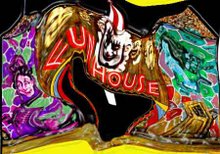An Afternoon in Sighisoara
The first thing one sees when arriving in Sighisoara is this street.
If you turn back the station looks like this.
One walks a bit of a zig zag path to get to a bridge across a river, but then you can begin to see the fortress on the top of the hill.
Before the river, one passes this beautiful large Orthodox Cathedral. It was built in 1934 and is quite striking with its black and white detail.
As one approaches the walls of the medieval city, one can look up and see the huge clocktower looming over the city.
The clock has 12 figures in total, but there are 7 on a wheel such that a different one can be seen every day of the week. These 7 figures are Roman gods.
Since I was there on Thursday, I got to see the figure of Jupiter clad in his crown. The lower figures are supposedly a drummer and an executioner.
The other side of the clock has six figures visible. The top two women represent righteousness and justice. Under them is a woman on the left with an olive branch representing peace and on the right is a little drummer who strikes the quarter hours. On either side of Righteousness and Justice are figures for night and day (not really visible in my blurry blow up).
The colors of the town were marvelous, clear, and gave the place great atmosphere.
Here is the entrance to the city. One walks up a ramp and then through the clock tower and is inside the city wall.
This is a view of the Orthodox Cathedral from the top of the city wall. (I went into the Cathedral on the way back and it is absolutely beautiful inside.
As one enters the fortress walls, one sees the birth house of Vlad Tepes. He is honored as one of Wallachia's greatest kings, who saved Romania from the Turks. Here is a sculpture of him.
This is the clock tower after one has entered the city walls.
And this is Vlad Tepes' birth house. Tepes is better known to the world as Dracula, although he has nothing whatsoever to do with vampires and it was his father who was given the named of Dracul when initiated into the Order of the Dragon in the 15th century.
Sadly the place has become a touristy memorial to a mystical story that isn't based on much of any kind of truth. The home now has a restaurant in the first floor and souvenir stands abound.
Sighisoara was primarily a German settlement named Schässburg and the influence of Germans is clearly visible in the building style.
Here is a tavern that has an interesting sign (with the sculpted head of the stag coming right out of the building.)
It seems the 7 dwarves are beloved all over the world!
The walls are non squared as with most medieval cities.
There were originally 14 towers on the wall, but now only nine are left. Each guild in the town was responsible for a tower. I think the one below is the Cobbler's Tower (known as Turnul Cizmarilor).
Regular people evidently still live within the city walls.
This is a passage up a hill known as the Scholar's Stairs. It was built in 1642 and has 175 steps.
This is a building on the edge of the cemetery.
The place was well kept and clean.
These head stones are probably quite old, but I couldn't read any thing on them .
This is the Church on the hill. It was started in 1345 and not finished until 1525. We were given a nice sheet talking about the altar pieces and various wedding chests that are found in the church.
 Here are some of the images painted on the walls.
Here are some of the images painted on the walls.
The figure in the middle has three faces to represent the trinity (supposedly).
People are renovating and soon the city will look completely new and flawless (which I'm not sure is such a good thing.)
Here is a picture of the sign for the restaurant in the Tepes home.
I don't really know what this building is, but the cupolas are stunning.
When I got back to the station there had been an additional delay. We waited and waited each few minutes yielding more bad news. Finally about three hours late the train did arrive.
I had wonderful chats with these people. Olga (below) was very nice and showed me where there was a small grocer so I could buy something else to eat.
It was SUCH a relief when I finally got home (even though it was well after 1:00 when I finally got back to the hotel room. I learned a new phrase, that everyone says when you tell them about your train delay, "What do expect? It's Romania." This is the self-deprecating phrase that the Romanians say when something goes wrong.
































No comments:
Post a Comment